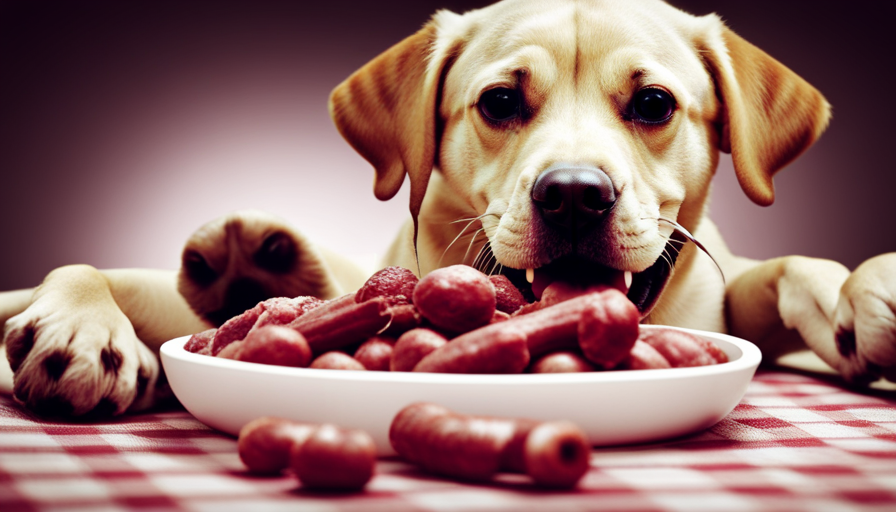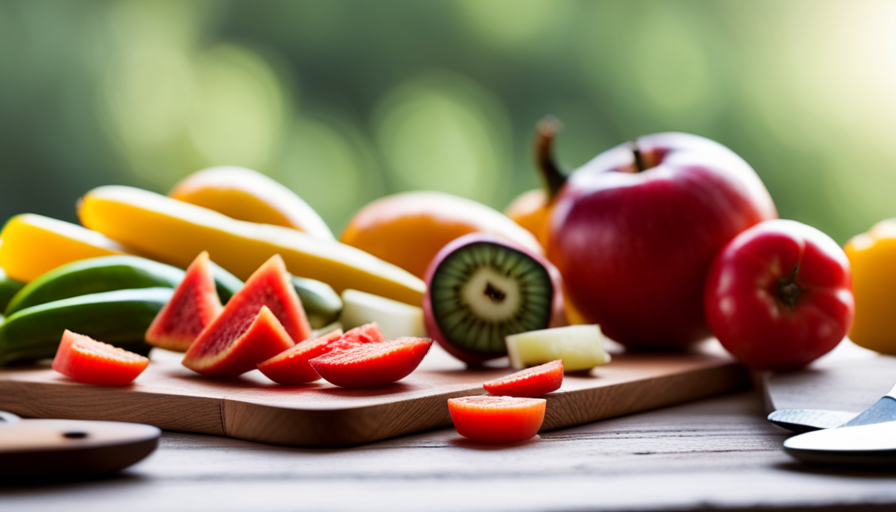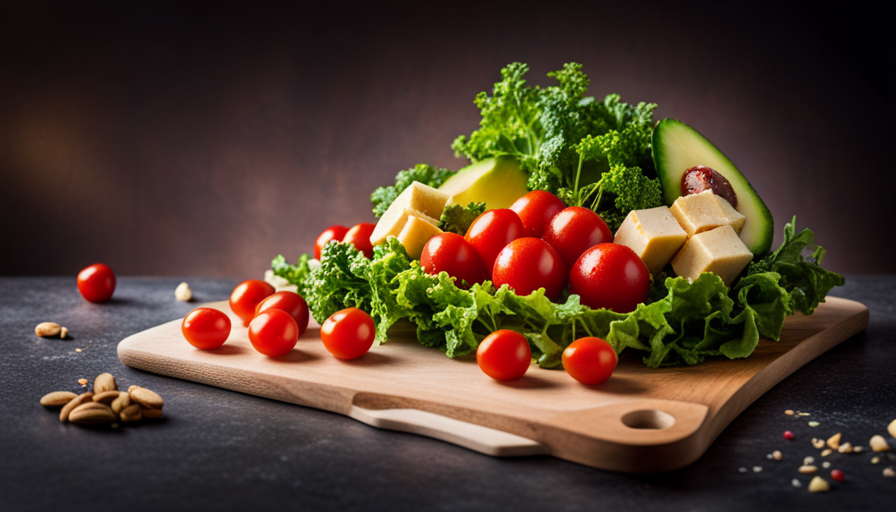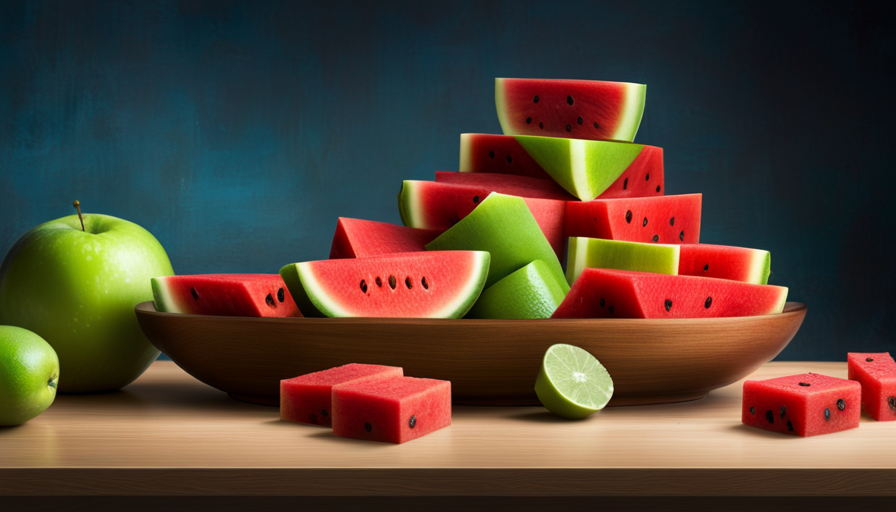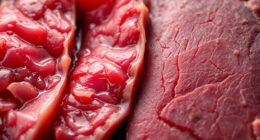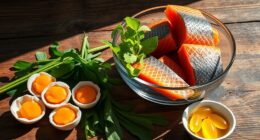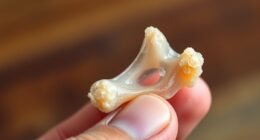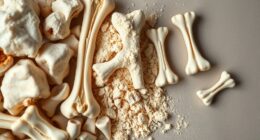Are you prepared to unlock your Labrador’s health and vitality to the fullest? If so, it’s time to delve into the realm of raw feeding! The saying goes, ‘you are what you eat,’ and this applies to your furry companion as well. Providing your Labrador with a raw diet can greatly benefit their overall health, from enhancing their immune system to improving their coat and digestion.
But where do you start? In this comprehensive guide, we’ll walk you through the ins and outs of feeding your Labrador raw food. You’ll learn about the benefits of a raw diet, how to assess their nutritional needs, and even dive into the nitty-gritty of properly preparing raw meals. We’ll address common challenges and provide tips to ensure your Labrador thrives on this natural and nutritious diet.
So, get ready to embark on a journey towards optimal health for your beloved Labrador!
Key Takeaways
- Raw feeding can provide numerous benefits for Labradors, including improved digestion, coat condition, and overall health.
- Labradors have sensitive stomachs, and processed dog foods can lead to digestive issues, making a raw diet a suitable option.
- A balanced raw meal for Labradors should consist of muscle meat, organ meat, bones, and vegetables to ensure essential nutrients are provided.
- Consultation with a veterinarian or canine nutritionist is recommended for determining portion sizes, assessing allergies, and ensuring a complete and balanced raw diet for Labradors.
Understanding the Benefits of a Raw Diet for Labradors
Feeding your Labrador a raw diet has so many amazing benefits that’ll make their tail wag with joy!
One of the main advantages of a raw diet for Labradors is its positive impact on their digestion. Labradors have a sensitive stomach, and processed dog foods can often lead to digestive issues such as gas, bloating, and diarrhea. Raw food, on the other hand, is more easily digested by their system, resulting in healthier and more regular bowel movements.
Not only does a raw diet improve their digestion, but it also has a significant impact on their coat condition. Labradors are known for their beautiful, shiny coats, and a raw diet can help maintain and enhance their natural luster. Raw food is rich in essential fatty acids, such as Omega-3 and Omega-6, which are crucial for healthy skin and a glossy coat. These fatty acids nourish the skin from within, reducing dryness and itchiness, and promoting a soft and shiny coat.
In addition to these benefits, a raw diet provides Labradors with a variety of nutrients that are essential for their overall health and well-being. It includes a balanced combination of proteins, vitamins, minerals, and antioxidants, which support their immune system, promote healthy joints, and contribute to optimal growth and development.
By feeding your Labrador a raw diet, you’re giving them the best chance at a long, happy, and healthy life. Their digestion will improve, their coat will shine, and they’ll thrive on the natural goodness of raw food.
So go ahead, make the switch, and watch your Labrador thrive!
Assessing Your Labrador’s Nutritional Needs
To properly nourish your furry companion, it’s crucial to first evaluate your Labrador’s specific dietary requirements.
When it comes to feeding a labrador raw food, it’s important to assess any potential allergies your dog may have. Some labradors may be allergic to certain proteins or other ingredients commonly found in raw diets, such as beef or chicken. It’s essential to observe your dog’s reactions to different foods and consult with a veterinarian if necessary.
In addition to evaluating allergies, it’s also important to consider whether your labrador requires any supplements. While a raw diet can provide many essential nutrients, there may be specific vitamins or minerals that your dog needs in higher quantities. Omega-3 fatty acids, for example, can support joint health and promote a shiny coat. Supplements such as fish oil or flaxseed oil can be beneficial in providing these nutrients.
When introducing supplements, it’s crucial to follow the recommended dosage and consult with your veterinarian. They can help determine the appropriate amount and frequency based on your dog’s individual needs. Remember, every labrador is unique, so what works for one dog may not work for another.
By carefully evaluating allergies and introducing supplements when necessary, you can ensure that your labrador is receiving a well-rounded and nutritious raw diet.
Choosing High-Quality Ingredients for a Raw Diet
When it comes to nourishing your Labrador, it’s vital to select top-notch ingredients that will make their taste buds dance with delight. Sourcing ethically raised proteins for your Labrador’s raw diet ensures that you are providing them with high-quality, nutritious meals. Look for meats that are free-range, grass-fed, and hormone-free. These proteins are not only healthier for your dog but also better for the environment. Incorporating nutrient-rich fruits and vegetables in your Labrador’s raw meals adds an extra boost of vitamins and minerals to their diet. Choose a variety of fruits and vegetables that are safe for dogs, such as apples, carrots, blueberries, and spinach. These ingredients not only provide essential nutrients but also add flavor and texture to your dog’s meals. To help you make informed decisions about the ingredients you choose, here is a handy table to guide you:
| Protein Sources | Fruits |
|---|---|
| Chicken | Apples |
| Turkey | Blueberries |
| Beef | Bananas |
| Salmon | Cranberries |
| Vegetable Sources |
|---|
| Carrots |
| Spinach |
| Sweet Potatoes |
| Broccoli |
By incorporating these high-quality ingredients into your Labrador’s raw diet, you can ensure that they are getting the nutrition they need to thrive.
Properly Preparing Raw Meals for Your Labrador
Get ready to create culinary masterpieces for your furry friend by preparing raw meals that’ll have your Labrador drooling and begging for more! When it comes to preparing raw meals for your Labrador, it’s important to consider their dietary requirements. Here are three key points to keep in mind:
-
Balance is key: A balanced raw meal for your Labrador should consist of muscle meat, organ meat, bones, and vegetables. This ensures that your dog gets all the necessary nutrients in their diet. Aim for a 70% meat, 10% organ meat, 10% bones, and 10% vegetables ratio.
-
Proper handling and storage: Raw meat can contain harmful bacteria, so it’s crucial to handle and store it properly. Always wash your hands and utensils thoroughly after handling raw meat. Store raw meat in the refrigerator or freezer to prevent spoilage and bacterial growth.
-
Variety is important: Just like humans, Labradors enjoy variety in their meals. Incorporating different types of meat, like chicken, beef, and fish, can provide a wide range of nutrients. Additionally, rotating vegetables and incorporating different organs can help maintain a balanced diet.
By following these guidelines and preparing raw meals that meet your Labrador’s dietary requirements, you can ensure they get a nutritious and delicious diet. Your furry friend will thank you with wagging tails and happy slurps!
Establishing Portion Sizes for Your Labrador’s Raw Diet
Make sure you accurately measure and adjust the portion sizes of your furry friend’s raw diet to ensure they’re receiving the perfect amount of nutrients for their health and well-being.
Establishing portion sizes for your Labrador’s raw diet is crucial to meet their nutritional requirements. Calculating the right amount of food is essential to maintain their ideal weight and prevent any health issues.
To establish portion sizes, you should consider factors such as your Labrador’s age, weight, activity level, and overall health. Puppies require more food than adult dogs, and active dogs may need larger portions. It’s recommended to consult with a veterinarian or a canine nutritionist to determine the specific nutritional requirements of your Labrador.
When calculating the portion sizes, it’s important to consider the balance of nutrients. Raw diets should consist of a variety of meats, bones, organs, and vegetables to provide a complete and balanced meal. The general guideline is to feed your Labrador 2-3% of their body weight per day, divided into two meals. However, this may vary depending on individual needs.
Monitoring your Labrador’s body condition is crucial to ensure they’re receiving the right amount of food. Adjust the portion sizes accordingly if they’re gaining or losing weight. Remember, it’s always better to slightly underfeed than overfeed to prevent obesity and related health problems.
By establishing accurate portion sizes and calculating their nutritional requirements, you can provide your Labrador with a balanced and healthy raw diet, promoting their overall well-being.
Transitioning Your Labrador to a Raw Food Diet
Now that you’ve established the portion sizes for your Labrador’s raw diet, it’s time to focus on transitioning your furry friend to this new way of eating.
Transitioning to a raw food diet can be a gradual process to ensure your Labrador adjusts well and avoids any digestive upsets.
The transitioning process involves gradually replacing your dog’s current food with raw food over a period of time. Start by introducing a small amount of raw food alongside their regular food, and slowly increase the proportion of raw food while decreasing the amount of kibble or canned food. This gradual transition allows your Labrador’s digestive system to adapt to the new diet.
When transitioning, it’s important to introduce new proteins gradually. Start with one protein source, such as chicken or beef, and feed it for a few days before introducing another protein source. This helps to prevent any potential allergies or sensitivities from arising and allows you to monitor your Labrador’s response to each protein.
Remember to always monitor your Labrador closely during the transitioning process and consult with your veterinarian if you have any concerns or questions. With patience and a gradual approach, you can successfully transition your Labrador to a raw food diet and provide them with a healthy and nutritious meal plan.
Addressing Common Challenges with Feeding Raw Food to Labradors
Dealing with common challenges while introducing a raw diet to your Labrador can be a rewarding journey towards a healthier and happier pet. Many Labrador owners may encounter obstacles when transitioning their furry friends to a raw food diet, but with patience and persistence, these challenges can be overcome.
Here are three common challenges and how to address them:
-
Overcoming picky eaters: Some Labradors may be hesitant to try new foods. To entice them, try mixing small amounts of raw food with their regular diet and gradually increase the portion over time. Adding a tasty topper like bone broth or a sprinkle of freeze-dried liver can also make the raw food more appealing.
-
Introducing raw food to older Labradors: Older Labradors may have more delicate digestive systems, so it’s important to introduce the raw food slowly. Start by incorporating small amounts of raw food into their current diet and gradually increase the portion. Additionally, consider consulting with a veterinarian to ensure the transition is done safely.
Remember, each Labrador is unique, and it may take some time for them to adjust to a raw food diet. Stay patient, provide positive reinforcement, and monitor their health throughout the process. Soon enough, your Labrador will be enjoying the benefits of a raw food diet.
Monitoring Your Labrador’s Health and Well-being on a Raw Diet
Keep a close eye on your furry friend’s overall well-being and health as you transition them to a raw diet, ensuring they receive the necessary nutrients and thrive on this new feeding regimen. Monitoring your Labrador’s weight and digestion is crucial to ensure they are adapting well to the raw diet.
To monitor your Labrador’s weight, regularly weigh them using a reliable scale. A healthy adult Labrador should maintain a stable weight, with gradual weight loss or gain indicating a potential issue. Sudden weight loss could be a sign of inadequate nutrient intake, while excessive weight gain may suggest overfeeding. Adjust the portion sizes accordingly to maintain a healthy weight.
In addition to weight, pay attention to your Labrador’s digestion. Observe their stool quality and frequency. On a raw diet, their stool should be small, firm, and odorless. Loose stools or diarrhea could indicate an intolerance to certain ingredients or an imbalance in their diet. If digestive issues persist, consult with your veterinarian for guidance.
To help you visually track your Labrador’s weight and digestion, use the table below:
| Date | Weight (lbs) | Stool Quality |
|---|---|---|
| 01/01/2021 | 75 | Small, firm, odorless |
| 01/14/2021 | 74 | Small, firm, odorless |
| 01/28/2021 | 76 | Small, firm, odorless |
By closely monitoring your Labrador’s weight and digestion, you can ensure they are thriving on a raw diet and make any necessary adjustments to keep them healthy and happy.
Incorporating Variety in Your Labrador’s Raw Food Meals
To truly delight your furry companion, make sure their meals are filled with a delightful array of flavors and textures. Incorporating variety in your Labrador’s raw food meals not only keeps them excited about mealtime but also provides a range of nutritional benefits.
Here are three reasons why variety is important for your Labrador’s diet:
-
Nutritional Assessment: Different types of meat, organs, and bones offer a wide range of essential nutrients that your Labrador needs to thrive. By incorporating a variety of proteins like beef, chicken, lamb, and fish, you can ensure they receive all the necessary amino acids, vitamins, and minerals for optimal health.
-
Enhanced Palatability: Just like humans, Labradors can get bored with repetitive meals. Adding variety in their diet keeps their taste buds stimulated and prevents mealtime monotony. You can rotate between different meats, vegetables, and fruits to offer a diverse range of flavors and textures, making their meals more enjoyable.
-
Reduced Food Sensitivities: Exposing your Labrador to a variety of proteins and ingredients early on can help reduce the chances of developing food sensitivities or allergies. By regularly changing their diet, you minimize the risk of them becoming intolerant to certain ingredients.
By incorporating variety in your Labrador’s raw food meals, you can ensure they receive the nutritional benefits they need while keeping their taste buds satisfied. Remember to consult with a veterinarian or a canine nutritionist to ensure you’re providing a balanced and appropriate variety of foods for your furry friend.
Consulting with a Veterinarian for Expert Guidance on Raw Feeding
Now that you’ve learned about the importance of incorporating variety in your Labrador’s raw food meals, it’s time to take the next step and consult with a veterinarian for expert guidance on raw feeding.
Consulting with a veterinarian can provide numerous benefits when it comes to ensuring the health and well-being of your furry friend. One of the main benefits is that they have the knowledge and experience to provide you with expert opinions on raw feeding. They can assess your Labrador’s individual needs, taking into consideration factors such as their age, weight, activity level, and any specific health concerns. With their expertise, they can help you create a balanced and nutritious raw food diet that meets all of your Labrador’s dietary requirements.
In addition to their expertise, veterinarians also have access to a wide range of resources and research on raw feeding. They stay up to date with the latest studies and developments in the field, allowing them to provide evidence-based recommendations for your Labrador’s diet. This can give you peace of mind knowing that you’re making informed decisions when it comes to your dog’s nutrition.
Overall, consulting with a veterinarian for expert guidance on raw feeding can be extremely beneficial for your Labrador’s health. Their knowledge, experience, and access to resources can help you create a well-rounded and nutritious raw food diet that will keep your furry friend happy and healthy for years to come.
Frequently Asked Questions
Can I feed my labrador a partially raw diet or does it have to be 100% raw?
Feeding your Labrador a partially raw diet is possible, but it’s important to note that a 100% raw diet is generally considered the best option. Labradors on commercial dog food may not receive all the nutrients they need, which is why raw food can be beneficial. However, a partially raw diet may not provide the same benefits as a fully raw one.
It’s best to consult with a veterinarian to ensure your Labrador is getting a balanced and nutritious diet. Remember, "you can’t have your cake and eat it too."
How do I handle and store raw meat for my labrador’s meals?
To handle and store raw meat safely for your Labrador’s meals, follow these guidelines:
-
Always wash your hands and any utensils or surfaces that come into contact with the raw meat to avoid cross-contamination.
-
Keep the raw meat refrigerated at or below 40°F (4°C) and separate from other foods to prevent the spread of bacteria.
-
Use airtight containers or resealable bags to store the meat and label them with the date to ensure freshness.
-
Regularly clean and sanitize your storage area to maintain hygiene.
Should I include supplements in my labrador’s raw food diet?
Should you include supplements in your labrador’s raw food diet?
While a raw food diet can provide many essential nutrients, it may still lack certain vitamins and minerals. To ensure your labrador’s nutritional balance, supplements can be beneficial.
Omega-3 fatty acids, for example, can support healthy skin and coat.
Consult with your veterinarian to determine the specific supplements your labrador may need based on factors such as age, activity level, and overall health.
Can I still give my labrador treats while they are on a raw food diet?
Yes, you can still give your labrador treats while they’re on a raw food diet. In fact, incorporating homemade treats into their diet can provide several benefits.
Homemade treats allow you to control the ingredients, ensuring they’re high-quality and nutritious. You can use ingredients like lean meats, fruits, and vegetables. Additionally, homemade treats can be a healthier alternative to traditional store-bought treats, which may contain additives and fillers.
Remember to always consult with your veterinarian for specific dietary recommendations.
How often should I rotate the proteins in my labrador’s raw food meals?
To ensure a balanced diet for your Labrador on a raw food diet, it’s recommended to rotate the proteins in their meals regularly. This helps prevent the development of food sensitivities and provides a wider range of nutrients.
Protein rotation allows your dog to benefit from different sources of amino acids, vitamins, and minerals. By incorporating various proteins like beef, chicken, fish, and lamb, you can provide a diverse and nutritious diet for your Labrador.
Can I Safely Feed My Labrador Raw Food While Traveling?
When it comes to feeding raw food to pets while travelling, it’s essential to plan ahead. Raw food can spoil quickly, so consider packing in a cooler with ice packs. Ensure the food is kept at a safe temperature and maintain proper hygiene when handling and serving the raw food to your Labrador.
Conclusion
Congratulations! You’ve now mastered the art of feeding your Labrador raw food. By understanding the benefits of a raw diet and assessing your dog’s nutritional needs, you’ve set the foundation for a healthy and vibrant life. Remember to choose high-quality ingredients and prepare meals with love.
Be vigilant in monitoring your Labrador’s health and don’t be afraid to consult with a veterinarian for expert guidance. With a little variety and a lot of care, your furry friend will thrive on this nourishing journey.

